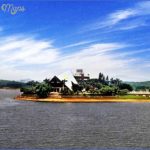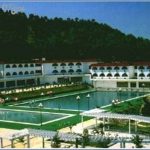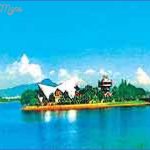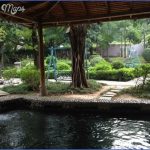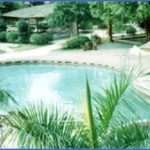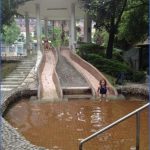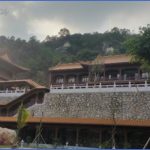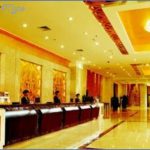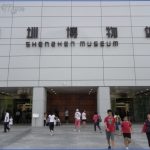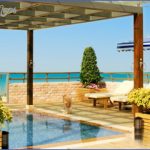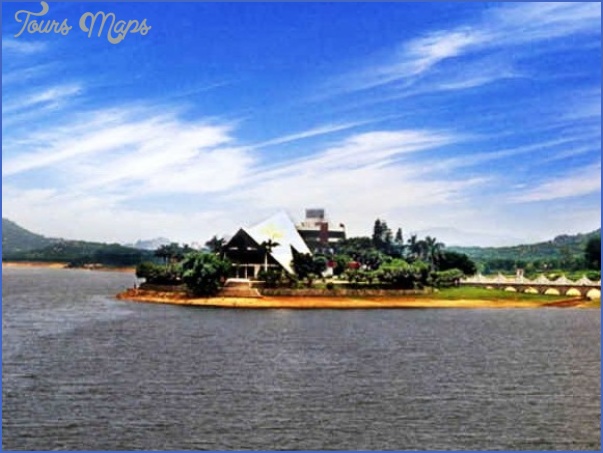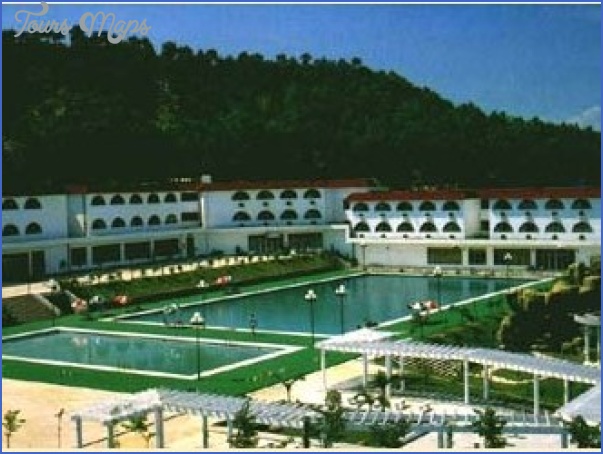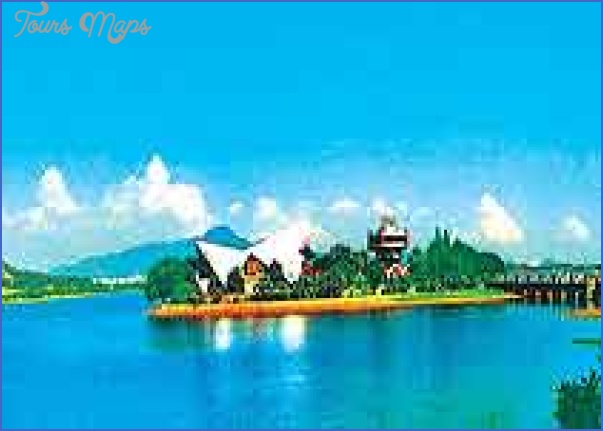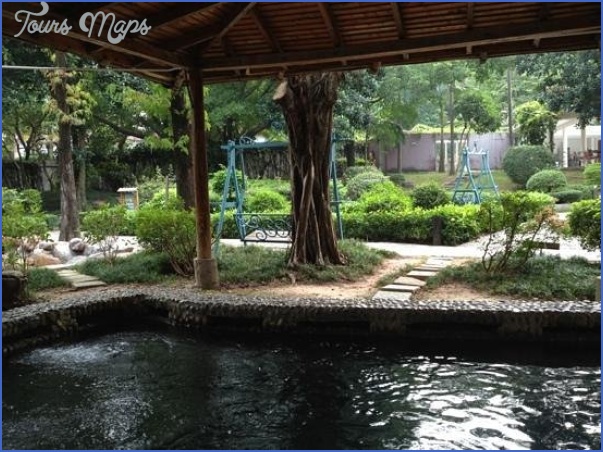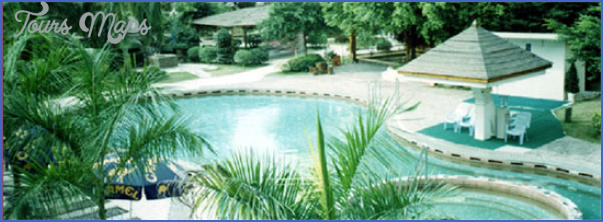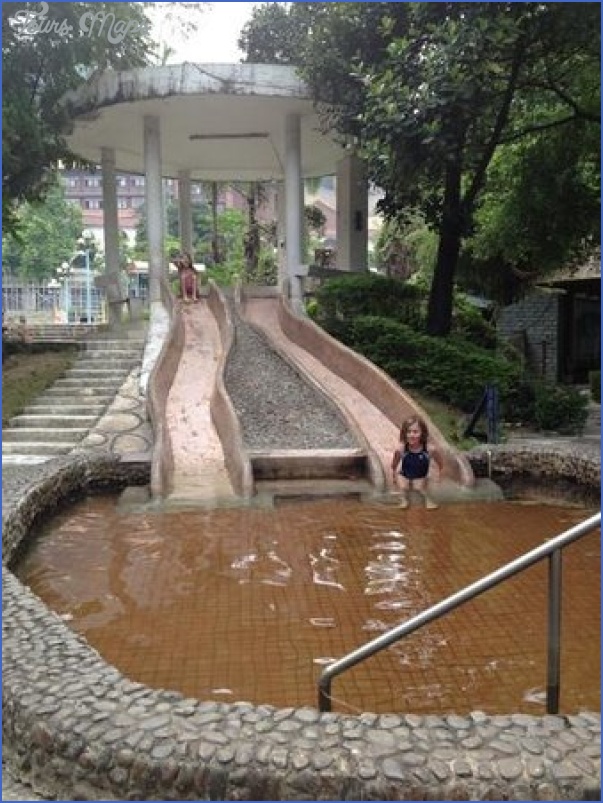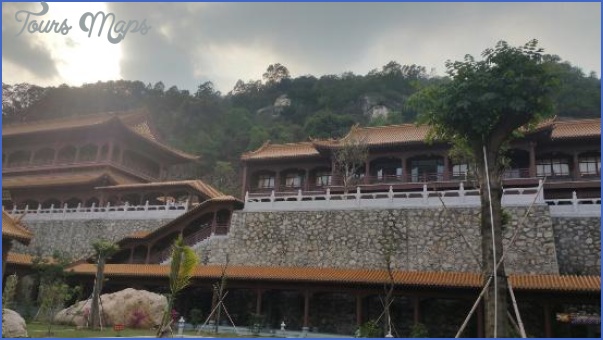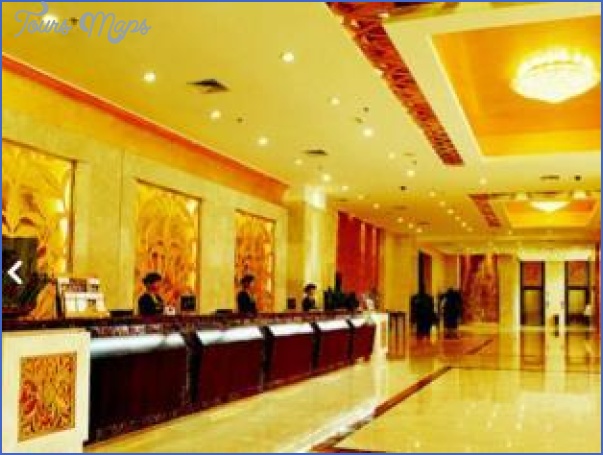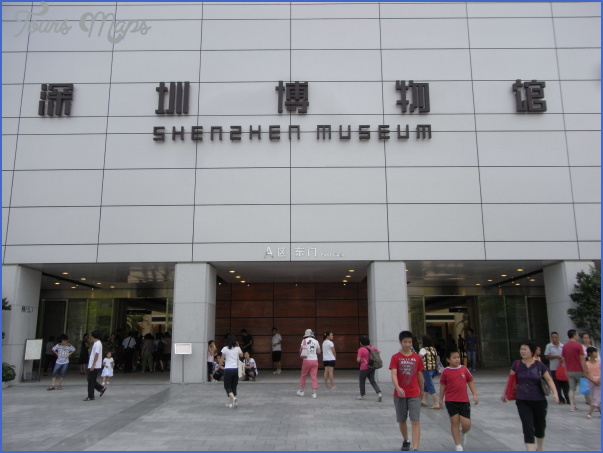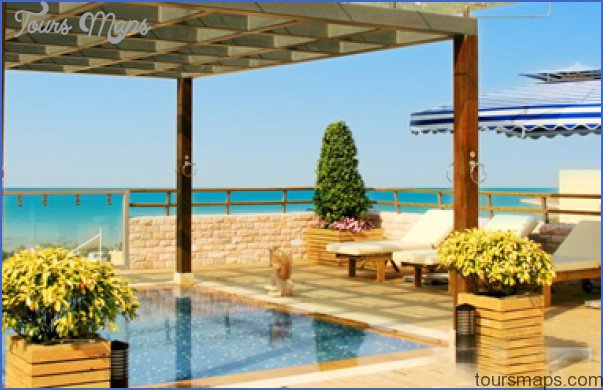To Xiao Liu’s surprise we descended the mountain relatively unscathed and set out for Shiyan and its hot springs. These springs have been famous for centuries. The first mention of them that we’ve been able to find is in the Ming Dynasty Chronicle of Xin’an County, the county that subsequently became Shenzhen and Hong Kong. In the eighth year of the Tian Shun Emperor 1464, the Chronicle listed Shiyan Hot Springs as one of its Eight Great Sights and praised its medicinal qualities and steaming waters.
We wound through factory towns; dusty streets set amongst spectacular mountains and soon we were in Shiyan town. Things brightened up a bit. The streets were wider and tree-lined and the factories seemed to be newer and of a better class. We passed Holly Hand Enterprise Company and Jack Pot Manufacturing Ltd, went under a pailou arch and we were there.
Pretty quickly we understood why this had been named one of the great views of Xin’an County. It’s the sort of scenery that puts feng shui men out of business. A perfect horseshoe of mountains surrounding a peaceful lake, in this case a reservoir for the city’s water supply. Not much seemed to remain from the Ming Dynasty or the Qing or even the Cultural Revolution. All the buildings were 1980s or 1990s style. Signs told us that there was a Gentleman Nightclub and a Lover Walk. Hmmmm. Well this has traditionally been one of the functions of hot springs in China. Maybe that would explain the white plaster statue of two rather frantic looking rabbits by the lake. But there was a mixed crowd and no shortage of children.
We drove further round the lake and were greeted by a large temple. It was Buddhist, clearly modern, with large groups of young monks standing round. On a rock, on the slope above it, was painted a large Buddha. The temple flowed down the slope, a riot of maroon walls and golden roofs. We walked to the top level.
Xiao Liu mumbled that he was xin Fuo de, a Buddhist and proceeded to make the, to western eyes, rather perfunctory obeisances which are de rigeur on such occasions. An elderly woman knelt in front of a large statue of the Maitreya or Laughing Buddha and threw divining sticks in an attempt to foresee her future. We engaged some monks in conversation.
It appears that there was a 19th century temple on this site; it was demolished during the Cultural Revolution. The current temple, called Hong Yuan Temple, is brand new, having only been opened in 2007. It is a subsidiary temple of Shenzhen’s great Hong Fa Temple.
We went down to the square in front of the temple and found a calligrapher. Not just an ordinary calligrapher. This was some of the most elegant expressive calligraphy that we had ever seen. Master Wang had come down to Shenzhen from Hubei some years ago to work in construction. But he chose the contemplative life, not as a monk, but as a painter and calligrapher. Large red and gold Buddhas smiled serenely down upon us from the scrolls that lined the walls. Master Wang resumed his place at his desk and his brush resumed its seemingly effortless path across the fine rice paper.
It was after 11.30 am, the usual Chinese lunchtime. Xiao Liu was ravenous and suggested that we eat at the temple. We went into the temple refectory. There were long rows of benches with stools lined up alongside. Along the benches were ranged the eating bowls and chopsticks of the monks.
Several young lay people were standing around. As usual in Shenzhen Buddhist monasteries, nobody seemed to be over forty. A tall man greeted us saying that the Laughing Buddha welcomed us to eat.
Xiao Liu regaled us with tales of eating at Buddhist Monasteries in his youth, and how washing his face ceremonially before eating always left him with a particular feeling of restfulness. The lay assistants told us about the daily routine of the monastery, how they ate at 5 am, 11 am and 5 pm, how their fare was simple, and how they never wasted anything. This sounded fine. We weren’t given to throwing large amounts of food away.
But then the food started to appear: enormous, bowl after enormous bowl. A bowl of green leafy vegetables was followed by a bowl of bean curd, mushrooms and chilli; followed by a bowl of soybeans and chili and a bottomless bowl of soup. Suddenly the prospect of not appearing wasteful became a worrying one.
The beancurd and mushrooms were artfully disguised in the Chinese Buddhist fashion to resemble meat. We mentioned this to the lay assistant and a cloud suddenly descended over his face. Xiao Liu whispered to us, You must never mention meat in a monastery. We paled and kicked ourselves.
With great effort and heroic assistance from Xiao Liu we finished the meal and slipped a donation into the box in front of the Abbot’s chair. In our case it was $100 which was probably a bit too much. But the nice thing was that nobody paid the slightest attention or put even slight pressure on us. In China this is unique. Xiao Liu made his obeisances before the Abbot’s chair and we left.
A word about these obeisances. The Chinese are flexible in their religious beliefs and flit from faith to faith with little effort. You’re usually a Daoist on big Chinese feast days and New Year. It’s good to be a Christian when you get married because the girl gets to wear the pretty dress. And Buddhist is a good thing to be when you die because you’ll be reborn as something, although this may be a cockroach. Most Chinese will make obeisances; the standing bow with hands joined in prayer called bai bai, in any place of worship, whatever the brand, and look slightly askance at anybody who doesn’t do it. We can’t bring ourselves to and we suspect that we share this with most westerners. But be advised.
After that we went to the hot springs, paid our $98 and immersed ourselves in the pools.
Don’t expect anything spectacularly luxurious here. There are some specials like a pool in an artificial cave and a pool within a pool. But mainly it looks like a public swimming pool. The water comes from a layer of sand wedged between layers of rock 110 metres below the ground. When it emerges from the ground it is a natural 63 ° C but cools to 45 °C before going into the pools. There are plenty of minerals; iodine, lithium and boron are mentioned, but there is no offensive sulphur smells like you often get at such places, and it’s just wonderful. We luxuriated in the hot pool, and then threw ourselves into the cold plunge pool. A therapeutic Chinese massage, a dressing gown, and we fell into an easy chair by the plate glass window overlooking the pools.
Address: Shiyan Hot Springs, Shiyan Town, Bao’an Entry: $10, Hot Springs entry $98
Buses: We warn you that this is NOT easy to get to and we advise you to combine the hot springs with a visit to Yangtai Mountain. That way you can take advantage of easy public transport connections between them.
Take the Metro to Windows on the World, Shi Jie Zhi Chuang. Next to Exit B there is a large underground bus station. Take bus no 392 to its terminus, which is the Shiyan Hot Springs. When you’ve finished, take bus no 769 from the place where you got off. This terminates at Yangtai Mountain.
SHIYAN HOT SPRINGS SHENZHEN Photo Gallery
Maybe You Like Them Too
- The Best Cities To Visit in The World
- World’s 10 Best Places To Visit
- Coolest Countries in the World to Visit
- Travel to Santorini, Greece
- Map of Barbados – Holiday in Barbados

